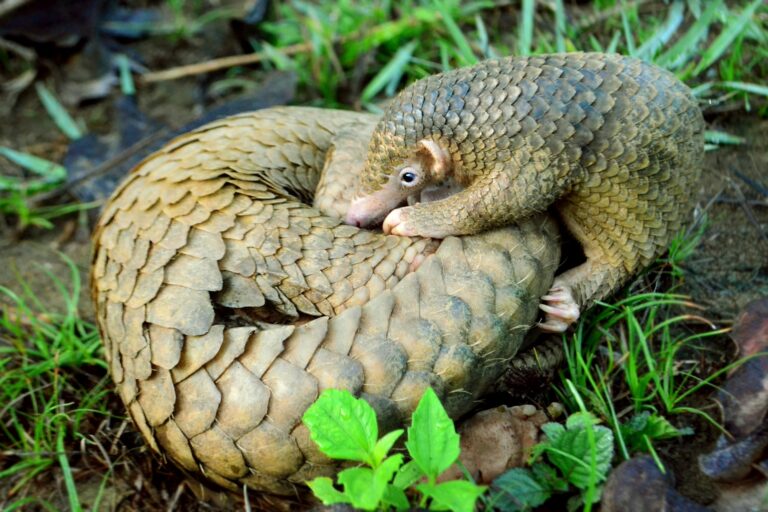- Pheasant-tailed jacanas practice a system of polyandry that sees each female maintain a “harem” of males, each tasked with looking after a clutch of eggs.
- That’s led to unusual parenting roles that see the males incubate the eggs and care for the young, and the females play the leading role in defending against attacks by predators.
- These behaviors have been documented for the first time in a study that looked at jacanas in the Anawilundawa Sanctuary in Sri Lanka, one of six Ramsar wetlands in the country.
- Researchers posit that the species evolved this system of polyandry to maximize the number of chicks that grow into adulthood, given the high mortality rate from predation in the open habitat of the wetlands.
COLOMBO — When it comes to super dads in the animal kingdom, the striking-looking waterbird known as the pheasant-tailed jacana is in a universe all its own. From incubating the eggs to taking care of the young, the male of the species excels. And in a reversal of the typical roles that play out in the wild, the female plays an outsized part in defending the nest and the young from predators.
These and other previously unknown details of the nesting behavior of pheasant-tailed jacanas (Hydrophasianus chirurgus) have emerged from a study carried out in Sri Lanka’s Anawilundawa Sanctuary, one of the country’s six Ramsar sites, or wetlands of international importance.

“We observed the strong defense response of the pheasant-tailed jacana to intrusions and found that, in most cases, the male responds by taking care of the young when there is a threat,” said study co-author Chandima Fernando, an ecologist and geographic information system (GIS) specialist from the Field Ornithology Group of Sri Lanka (FOGSL).
The male jacana, he said, has a special way of getting the young out of danger by tucking them under its wings and moving swiftly away. But on their observation site, Fernando mostly observed the males quickly guiding the young to safe hiding spots.
The female also takes part in defending the chicks, especially against aerial threats from other birds, the study found. In fact, they played the main defensive role rather than merely supporting male defense actions against aerial threats, Fernando said.

Super dads and defender moms
Jacana chicks are a common target for other birds, including predatory species such as the shikra (Accipiter badius) and Brahminy kite (Haliastur indus), as well as the white-breasted kingfisher (Halcyon smyrnensis), while the eggs are targeted by birds like the purple swamphen (Porphyrio poliocephalus). Brahminy kites are the most frequent attacker, and whenever they mount an aerial attack on a jacana nest, it’s the female that responds first. Female jacanas are slightly larger than the males, which could explain why they’re the ones to confront dangers from the skies.
Their response varies from making a warning call to flying up and striking a threatening pose. There are also times when the female jacana actively pursues the intruder, combat style, Fernando said. As the breeding progresses, the female’s involvement in defending the net increases, the researchers observed.

A wetland is an open habitat with little or no space to hide from predators, so the chicks, little fluffy balls of feathers, need to be actively protected from other threats. Water monitors abound in the Anawilundawa wetland, as do snakes and other reptiles, which all hunt the young jacanas. That gives the male bird a busy time taking care of the young, Fernando said.
The researchers studied nine breeding groups of pheasant-tailed jacanas during the breeding season, which ran from nest building to fledging state. The team divided the breeding season into three phases for better observation: pre-incubation, when a pair is involved in mating and nest building, which goes on for six to eight days; incubation, which lasts for about 21 to 26 days, when the male plays a prominent role; and chick rearing, the final 21 days, when the female’s defensive behavior is heightened.
Each female jacanas maintains a large territory, within which multiple males compete for and defend smaller territories of their own. They don’t tolerate other individuals of their own species trespassing, chasing them out if they cross the boundaries. The researchers observed that male jacanas responded to intruder males, while females responded to intruding females.
The study team used differences in individual color patterns, markings, and the length and the quality of the tail to identify the individual jacanas in the study sites, as a way to tell residents apart from intruders.
“Jacanas have a polyandrous breeding system, so the competition among males for breeding opportunities including risks of cuckoldry could be making the males more defensive of their territories from other males,” Fernando told Mongabay.

Different mating system
Jacanas are tropical water birds that have adapted well to life in a lake with vegetation. They have long straight claws and toes that spread out their
weight, allowing them to walk on the floating aquatic vegetation with ease. That’s earned them the names “lily birds” and “lily trotters.” Their common name refers to the elongated central tail feathers that they develop during the breeding season.
Compared with other animals, birds typically have an exemplary family life, with about 90% of species being monogamous, i.e. a single male and a single female mating. But jacanas are a notable exception, with each female maintaining a “harem” of males, each of which in turn looks after a clutch of eggs.
“We have to do more studies to understand why some birds adapt to the polyandrous mating system, but a common understanding is that breeding strategies are basically related to the environment they live in,” said study co-author Sarath Kotagama, an ornithologist and emeritus professor of ecology who pioneered bird-watching and ornithological studies in Sri Lanka in recent decades.

The open habitats that jacanas prefer create conditions for high rates of mortality. That means there’s a real need to ensure as many chicks as possible grow into adulthood. Researchers posit that having an increased number of chicks through multiple broods could be the strategy that jacanas have evolved to increase the survival rate of the species, Kotagama told Mongabay.
Citation:
Fernando, C., Kotagama, S. W., Rendall, A., & Weston, M., (2022). Defense of eggs and chicks in the polyandrous pheasant-tailed jacana (Hydrophasianus chirurgus) in Sri Lanka: Sex-roles, stage of breeding, and intruder type. Waterbirds, 44(3), 363-369. doi:10.1675/063.044.0311
Banner image of a male pheasant-tailed jacana incubating eggs and discharging the majority of parental duties, courtesy of Jagath Gunawardana.














